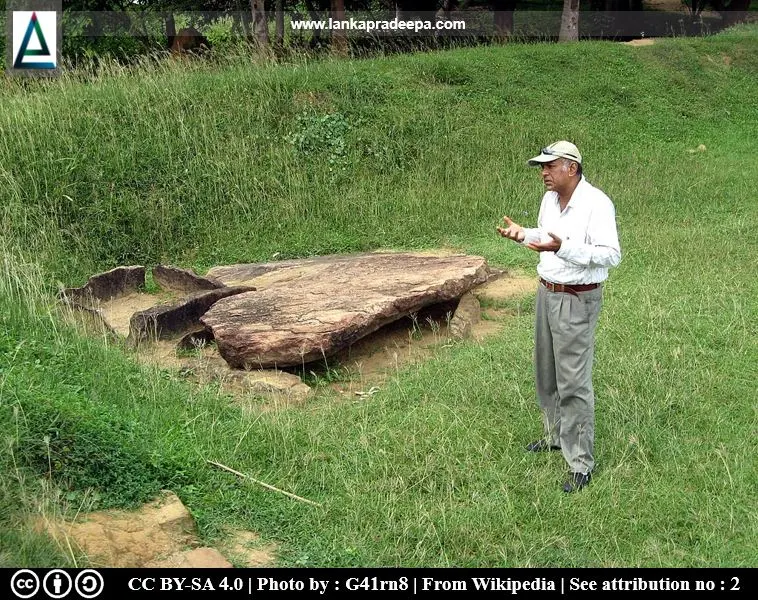
Ibbankatuwa Megalithic Cemetery, also known as Ibbankatuwa Proto-historic Burial Site (Sinhala:ඉබ්බන්කටුව මෙගලිතික සුසාන), is an ancient burial site situated south of Dambulu Oya Reservoir in Dambulla in Matale District, Sri Lanka. Extended in an area of about 13 hectares, the site comprises a large number of burials in cists made of stone slabs dating to the 7th century B.C. The cemetery is considered the biggest and the best-preserved proto-historic burial site in the country.
The Cemetery
The cemetery site is located on the left bank of the Dambulu Oya, a tributary of Kala Oya. It generally consists of stone cist-type burial graves of the Megalithic tradition. The burial chambers are square and rectangular in shape and have been constructed by placing granite slabs vertically erected (Karunaratne, 2010). Several chambers were covered with capstones and some of them were visible on the surface even before the excavations. In 1984, surface explorations performed at the site exposed a few non-Brahmi Symbols (pictograms) inscribed on three separate cist capstones (Seneviratne, 1989).

Large and small clay pots containing human ashes were found placed inside the chambers. Certain clay pots were cylindrical in shape and smaller containers were discovered inside some of these clay vessels. Some tombs consist of multiple urns. A few pots contained minute bone fragments but none of the tombs contained complete or partial skeletons (Karunaratne, 2010).
During the excavations, a large number of beads made of minerals such as clay, carnelian, onyx, and agate were found inside the chambers (Karunaratne, 2010). A majority of beads discovered in Ibbankatuwa are said to be exotics that originated hundreds of miles away in peninsular India (Karunaratne, 2010). Cloth pins, bangles, leaf-shaped diadem, and metal objects such as iron, copper alloy, and gold were among the other findings of Ibbankatuwa (Karunaratne, 2010).
Settlement site
It is believed that the Ibbankatuwa cemetery was associated with a settlement belonging to the early Iron Age. Polwatta, an ancient human settlement located not far from the Ibbankatuwa burial site is considered to be the complementary human settlement of this burial site.
The Ibbankatuwa settlement was first excavated during the PGIAR-CCF-KAVA (Postgraduate Institute of Archaeology-Central Cultural Fund-The Kommission fur Algemeine und Vergleichende Archaeologie) collaboration project in 1988 (Karunaratne, 2010). More excavations were done during the 1989, 1990, and 1991 field seasons. According to C14 data, it was found that the site was occupied for several centuries, at least from the Proto-historic/Early-historic transition phase to the middle historic period (Karunaratne, 2010).
Ibbankatuwa is considered the only Proto-historic cemetery site in Sri Lanka where a corresponding settlement has been excavated (Karunaratne, 2010).
Excavations
The first excavation was performed in the Ibbankatuwa burial site in 1970 by Dr Raja De Silva, a former Archaeological Commissioner (Karunaratne, 2010). Consideration was again given to the site in 1982 when the Dambulla Cultural Triangle was established(Karunaratne, 2010). After that, two excavations were conducted in 1988 and 1990, by a team of German (KAVA) and Sri Lankan (CCF & PGIAR) archaeologists led by Prof. Senake Bandaranayake. They investigated a cluster of 21 burial chambers and its corresponding C14 data revealed that the cluster was in use at least from around 600 B.C.
The third excavation was carried out in August 2015, by the Central Cultural Fund. They excavated a new area located west of the cluster of 21 burial chambers. During this excavation, 47 burials, 26 stone cists, and 21 urn burials were discovered by them.
The conserved site was opened for public viewing on 11 February 2017.
A Protected Site
The megalithic tombs, situated in the village of Ibbankatuwa, in the Grama Niladhari Division of Ibbankatuwa, in the Divisional Secretary’s Division of Galewala, are archaeological protected monuments, declared by a government gazette notification published on 23 October 2009.



See Also
#) Pre & Proto-historic Burials in Sri Lanka
References
1) Karunaratne, P.P., 2010. Secondary state formation during the early iron age on the island of Sri Lanka: The evolution of a periphery. University of California, San Diego. pp.122-123,180,182, 184-185,190.
2) Seneviratne, S., 1989. Pre-state chieftains and servants of the state: a case study of Parumaka. pp.99-130.
3) The Gazette of the Democratic Socialist Republic of Sri Lanka: No: 1625. 23 October 2009. p.1596.
Attribution
1) Ibban Katuwa, Sri Lanka 0021 by G41rn8 is licensed under CC BY-SA 4.0
2) Ibban Katuwa, Sri Lanka 0024 by G41rn8 is licensed under CC BY-SA 4.0
3) Ibban Katuwa, Sri Lanka 0027 by G41rn8 is licensed under CC BY-SA 4.0

